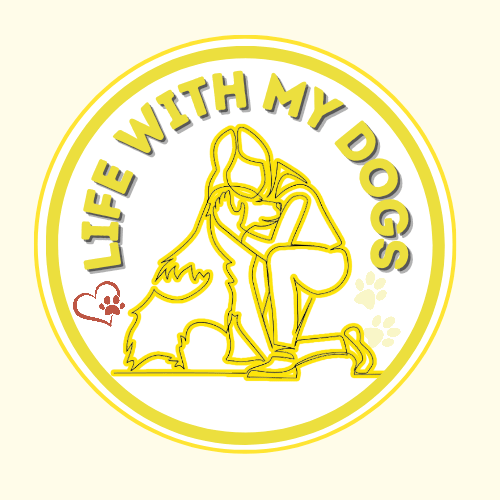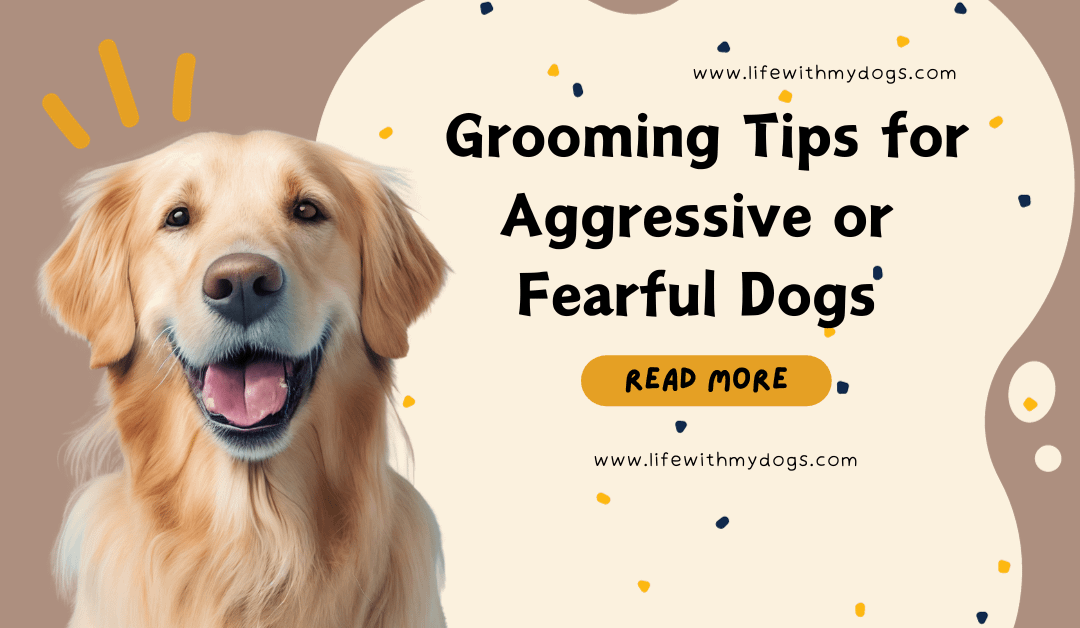LifeWithMyDogs is supported by our audience. When you purchase through one of our links, we may earn a small affiliate commission. As an Amazon Associate I earn from qualifying purchases. Your cost is not affected.
**********
Grooming an aggressive or fearful dog can be a challenging experience, but with the right approach and techniques, it can become a manageable and even bonding activity. Understanding the unique needs of a dog who may react unpredictably to grooming is crucial in ensuring the safety and comfort of both the pet and the groomer.
With patience and consistent positive reinforcement, even a dog with previous negative experiences with grooming can learn to tolerate, if not enjoy, the grooming process. Knowing how to read your dog’s body language, recognize signs of fear or aggression, and introduce grooming tools and techniques to reduce anxiety is important.
Grooming Tips for Aggressive or Fearful Dogs: Essential Strategies for a Safe Experience

Creating a calm and safe environment is essential when preparing to groom a dog that is aggressive or fearful. Techniques incorporating gradual introductions to grooming tools and rewards for cooperative behavior can foster trust and reduce stress.
By acknowledging and respecting the dog’s boundaries and stopping the grooming session if the dog becomes overwhelmed, you build more confidence for future grooming. The ultimate goal is to transform grooming from a stressful ordeal into a routine part of a dog’s life where they can feel secure.
Key Takeaways
- Effective grooming strategies prioritize understanding your dog’s behavior and comfort levels.
- A gradual, reward-based approach to introducing grooming tools can improve an aggressive or fearful dog’s tolerance.
- Employing calm, patient handling during and after the grooming process helps prevent future adverse reactions.
Understanding Canine Behavior

When grooming a dog with aggression or fear issues, it’s vital to understand their behavior. This comprehension aids in safer, more effective grooming sessions.
Recognizing Signs of Aggression
- Facial Expressions: Look for bared teeth, a wrinkled muzzle, and an intense stare.
- Body Language: Stiffening of the body, raised hackles, and a rigid tail can indicate aggression.
- Vocalizations: Growling, snarling, or barking aggressively are audible cues.
Identifying Fear-Related Behaviors
- Posture: A fearful dog might tuck its tail, crouch, or lower its body.
- Avoidance: Your dog may turn its head away or try to move away from you or grooming tools.
- Panting or Drooling: Excessive panting or drooling can be signs of stress or fear.
Preparing for Grooming

When grooming an aggressive or fearful dog, preparing effectively can set the tone for the entire experience. It’s crucial to create a space that minimizes stress for your dog and choose tools that ensure safety and efficiency.
Creating a Calm Environment
Your first step is to set up a safe and quiet area. This environment should be away from loud noises and high-traffic areas to prevent additional anxiety for your dog.
You can use calming scents like lavender or pheromone diffusers designed for dogs to help soothe their nerves. Additionally, familiar items such as their favorite blanket or toy can provide comfort during grooming sessions.
Choosing the Right Tools
Select the appropriate tools for grooming, prioritizing your dog’s comfort and safety. Start with a quality grooming table with a non-slip surface and a restraint-like comfortable grooming loop to secure your dog gently. Invest in rounded-tip scissors, safety clippers, and various combs and brushes that match your dog’s coat type.
Remember, using a muzzle may be necessary for particularly aggressive behaviors to ensure your and the animal’s safety. It’s advisable to have protective gloves and calming aids ready, as mentioned in doggieconnect.com.
Approach and Handling

Your approach and handling techniques are crucial when dealing with aggressive or fearful dogs. You aim to make the grooming experience as calm and stress-free as possible for you and your dog.
Positive Reinforcement Techniques
Positive Reinforcement is critical in helping an aggressive or fearful dog associate grooming with a pleasant experience. You should:
- Reward calm behavior with treats or verbal praise to reinforce that stillness and cooperation are desirable.
- Gradually introduce grooming tools and sessions, allowing your dog to become comfortable at their own pace.
Reference for techniques: Calming techniques for grooming.
Safe Handling Practices
For Safe Handling, ensure that you:
- Use proper restraint techniques that are safe for you and your dog, avoiding excessive force at all times.
- Be aware of body language, both yours and your dog’s, to prevent and de-escalate potential aggressive reactions.
Additional information on handling: Identifying body language cues.
Grooming Process

Addressing the grooming needs of anxious or fearful dogs requires a gentle approach and a strategic process to ensure their comfort and safety.
Bathing Tips for Anxious Dogs
When bathing your anxious dog, create a calming environment by using warm water and speaking in soothing tones. A non-slip mat is essential to prevent slipping, which can heighten anxiety. Introduce your dog slowly to water and avoid splashing, as sudden movements can escalate stress.
Clipping Nails Without Stress
Nail clipping can be incredibly stressful, so make each session short and offer rewards. Use sharp, specially designed dog nail clippers for a quick and clean cut, reducing the chances of pinching or splitting the nail, which can be painful and increase fear.
Brushing Techniques for Sensitive Dogs
Use brushes with soft bristles, and be mindful of areas where the skin is thinner, like the belly and behind the ears. Start with short sessions and gently stroke your dog with the brush before brushing them to familiarize them with the tool and sensation. Praise calmly and consistently throughout the process to create positive associations.
Post-Grooming Care

Following a grooming session, especially if your dog has shown signs of aggression or fear, there are specific measures you should take to ensure the experience ends positively and does not contribute to further stress.
Rewarding Good Behavior
After the grooming session, immediately reward your dog for reinforcing a positive association with grooming. Rewards can include:
- Favorite Treats: Give your dog some of its favorite treats as favorable reinforcement.
- Playtime: Engage in a fun activity your dog enjoys, like playing fetch or tug-of-war.
- Affection: Offer plenty of cuddles and verbal praise to make your dog feel comfortable and loved.

Monitoring Stress Levels After Grooming
Monitoring your dog’s behavior during grooming hours is crucial, as they may still be experiencing stress. Here are signs to look for and actions to take:
- Body Language: Watch for signs of stress, such as panting, pacing, or hiding. Provide a quiet, comfortable space for your dog to relax if needed.
- Eating and Drinking Habits: Ensure your dog resumes normal eating and drinking habits. If not, it might be a sign of persistent stress.
By recognizing good behavior with rewards and keeping an eye on your dog’s post-grooming behavior, you help to create a more positive experience that can lead to lessened fear or aggression in future grooming sessions.
Video Credit: @GoGroomer
Wrapping It Up
Grooming aggressive or fearful dogs requires patience and understanding. Use calming techniques and take it slow. Reward good behavior to build trust.
Consider professional help if needed. Remember, safety for you and your dog is a priority. With time and care, grooming can become a positive experience.
Frequently Asked Questions
What techniques do professional groomers use to calm an aggressive dog?
Professional groomers often employ calming techniques such as remaining calm themselves, introducing grooming tools gradually, and using positive reinforcement. Some groomers use specific methods to help ensure a stress-free environment.
Can sedatives be safely used when grooming a dog with aggressive behavior, and if so, what are the guidelines?
Yes, sedatives can be safely used under veterinary guidance. The main guidelines include using the correct dosage and understanding the potential risks. It is also essential to only use medications a veterinarian prescribes.
What are the best practices for grooming a fearful dog at home?
Best practices for grooming a fearful dog at home include creating a peaceful environment, using treats and praise to associate grooming with positivity, and being patient. It’s crucial to proceed slowly and let your dog get comfortable with each grooming step at their own pace.
What precautions should be taken when grooming a dog aggressively towards strangers?
When grooming a dog that is aggressive towards strangers, it’s vital to keep the grooming area quiet to reduce stress. Muzzle the dog if necessary, and never leave a stranger alone with the dog. Keeping the dog restrained during grooming may also be helpful to prevent any sudden movements.
How should a dog’s face be groomed when it exhibits aggressive tendencies?
Grooming the face of an aggressive dog requires extreme caution. Use minimal restraint to avoid escalating the dog’s stress and talk soothingly. Ensure you fully control the dog’s head and employ swift, confident movements to minimize discomfort.
Are specialized grooming services available for dogs not receptive to traditional grooming methods?
Yes, specialized dog grooming services, such as those designed for aggressive dogs, require a different approach. These services often involve experienced groomers dealing with behavioral challenges and may offer more personalized attention.
Learn More About Dog Care!
Discover gadgets like this that simplify your life with dogs. Find tools for more accessible, more enjoyable pet care. Unlock essential dog care tips with us. Join our Facebook, Instagram, and Twitter for practical advice, real stories, and a community focused on better dog care.
Facebook: https://www.facebook.com/1LWMD/
Instagram: http://instagram.com/lifewithmydogs2
Twitter : https://twitter.com/LifeWithMyDogs9
Learn more tips about dog care and more with us – where every dog’s health is a priority.
Read More


